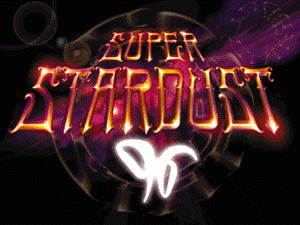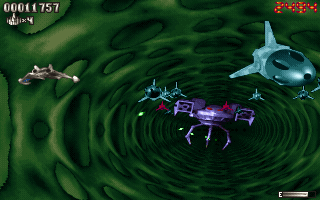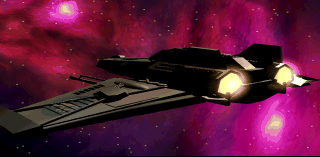

History: First released two years ago for the Commodore Amiga CD-32 platform. One of the best games released of it time in the retro arcade, classic shooter format. GameTek came into existence in 1988 and has released about 100 titles and the company supports eleven different platforms including the PC and Macintosh.
Plot: Last time, Professor Schaumund, an evil twisted mutant genius
penguin, tried to conquer the galaxy and kidnap princess Voi Levi (or
was it kidnap the galaxy and conquer the princess? No matter! - Ed).
The pixelated Professor penguin was prevented from perpetrating his plot
by your powerful Panther PX2 pfighter plane. (alliteration is brought
to you at no extra cost. - Ed.) Now the professor not only want the
galaxy and the princess but also revenge on you and all of mankind.

Coincidentally, you have been assigned to Starbase Foak-474, when on April 1, 2038, in order to be out of the country during the annual April 15 tax filing season, Professor penguin and his newly updated fleet of ruthless asteroid-shaped spaceships invades near your station, and adds tax evasion to his ever lengthening list of crimes. You are again called into the breach to defend the universe, your princess, and life as we may, or may not, know it.
Game play: To quote Mike Giovetti, see the biography section, this is another asteroids rip off. The game is based upon the original asteroids, which was one of the most popular games of the distant computer past. Like most of the early games, there was only one screen and you were lucky if there was a change in backgrounds.
Asteroids was originally a black and white ray traced graphical game with only the outlines of screen objects shown. The asteroids would come at you from all 360 degrees of the screen while you held out in the center. When you shot an asteroid it broke into two smaller asteroids and you received points. You could keep shooting until the pieces were so small that they finally disappeared. Occasionally, little space ships of two sizes would fly into the playing field and shoot at your ship. If you were hit by the little ship or an asteroid piece you were destroyed. You could warp to a different random location on the screen as a desperation move.
You could turn your ship around with maneuvering jets but you could only fire to the front. If you wanted to go back in the direction you came from you turned the ship around 180 degrees and thrust back in the other direction, since there were no breaking jets. Mike Giovetti, The Computer Show Co-Host and my 13 year old son, is upset that the game does not have brakes. When I explained to him that the original game had no brakes, he vaguely remember playing it when he was very young.
Super Stardust 96 (SS96) has six different progressively more difficult
levels to choose from of progress to. The game can be played from these
levels once the password to the level is known. SS96 has optional
autofire, and can optionally set the number of lives to extend play.
Newly added to the game is a three way gun, and power ups that come out
of destroyed asteroids. The power ups bestow extra lives, mega bomb,
gun upgrades, and other game enhancements. When the level is finished,
your play is monitored and an appropriate comment on the play encourages
you to perform better.

The new game has several new alien space ships including the fire spiller, that spits fire while following you, and the predator, which is invisible and can only be shot when he appears. Once all six levels are successfully traversed, you move through a warp tunnel with ships, asteroids, and other obstacles to the next series of level screens. The entire game is composed of 30 levels, three tunnels and four worlds.
Interface: You can redefine the keys to make the game easier to play from the keyboard.
Weapons: There are six weapons in the game: three way, bouncer, plasma, flamer, burster, and missiles.
Graphics: Fully animated, ray-traced enemies, light-sourcing with shadows, real-time glow and transparency effects, and smooth 70 MHz scrolling on the fully rendered three dimensional graphics make the game beautiful to look at and play
Animation: Cinematic sequences start and end the game, but unfortunately, are not used to reward you for progress within the game.
Voice actors:
Music score: Fifty minutes of original techno music with a driving rhythm.
Sound effects:
Utilities: You cannot save your game, but you can re-enter at the beginning of the level with an eight character level code.
Cheat: 09FJPV464IJ is one level code.
Future plans:
References:
www.pncl.co.uk/~martinc/cd32_reviews/super_stardust.html, 83%
www.roadrunner.com/~cyberrus/old.html
French review: www.pair.com/luduswg/VOCI/APRILE/stardust.htm
German: http://w3pca.pcaction.de/pcg0696/review/stardust
Jason DíAprile, www.cdmag.com/action_vault/super_stardust_review/page1.html, 4/5 (80-90%)
Editors Coming Soon Magazine, www.megatoon.com/~t15/issue14/sstard96.htm, 82%
www.gamesmania.com/cgi-bin/english/default.cgx
Matthew Klem, www.gamepen.com/softwarepen/pc/super_stardust.html, B, (85%).
Frank Snyder, www.nuke.com/cgr/reviews/9607/stardu/stardu.htm, 90%.